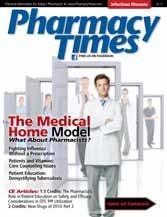Infectious Diseases


Rupal Patel, PharmD Mary Barna Bridgeman, PharmD
Case One—The Common Wart
ML is a 32-year-old woman who comes to the pharmacy complaining of a nodule on a knuckle of her left hand. Upon inspection, you notice a single nodule smaller than 0.2 cm in diameter with a scaly, cauliflower-like appearance. She is concerned because it has been on her knuckle for the past 2 weeks; however, she complains of no pain. She wants something to remove it as soon as possible.
ML reports no known medication allergies or other medical conditions, and says that she has not yet tried any other remedies to cure the wart. What would you recommend for ML to help remove her wart and prevent its spread to others?
Answer
Warts are infections of the top layer of the skin caused by human papillomaviruses (HPVs).1 Warts are typically classified according to their location; ML is likely suffering from a common wart (verruca vulgaris), which is typically found on the hands, fingers, elbows, and knees.
Other types of warts include flat warts, usually found on the face or neck, and plantar warts, typically found on the undersurface of the foot. Plantar warts will frequently have thrombosed blood vessels, causing them to appear as black marks. They can sometimes be uncomfortable if they are located in weightbearing areas of the sole of the foot.1
Although there is no specific therapy for curing warts, use of topical agents can decrease pain or help with wart removal. Because ML is concerned about removing the wart, we can recommend cryotherapy at home. Additionally, counseling ML on handwashing and the importance of good hygiene, in addition to covering the wart and using a specific towel for drying her left hand, may be prudent, as warts may transmit the HPV to others or spread to other body surfaces.
Cryotherapy has been used by health care professionals for several years for wart removal, and a formulation for home use was approved by the FDA in 2002.2 Topical aerosol sprays containing dimethyl ether and propane (DMEP), available in several over-the-counter wart remover products, allow patients to remove warts at home. Examples of cryotherapies include Compound W Freeze Off, Dr. Scholl’s Freeze Away Wart Remover, and Wartner Wart Removal System.
Therapy with DMEP spray applied to the wart will freeze the skin tissue and affected skin, allowing a blister to form beneath the wart. After approximately 10 to 14 days, the frozen skin will fall off, revealing newly formed skin.3
Topical salicylic acid preparations can also be used for self-treatment of common or plantar warts. When used, patients should notice improvement within the first or second week of treatment and can expect complete healing within 6 to 12 weeks.
Case Two—Nail Fungus
GM is a 42-year-old man who comes to the pharmacy to refill his prescriptions for glyburide and metformin. He is also looking to purchase an OTC nail polish he can use to treat a nail infection. Upon questioning, he complains of a yellow, rough nail on his right thumb. He explains that the nail has been like that for 3 months and that it had fallen off when he used this nail polish previously. The nail eventually grew back and it took some time before it turned yellow again. He reports using the nail polish for more than 3 years and he states that it has worked wonders. What would you recommend to GM regarding his infection?
Answer
For fungal infections, self-treatment is only recommended for tinea cruris (groin), tinea corporis (body), and tinea pedis (foot); fungal infections of the scalp (tinea capitis) and nails (tinea unguium) are excluded from self-treatment. 4 Additionally, the treatment of fungal infections in individuals with diabetes should be referred to a primary care provider for management.4 It would be prudent to recommend GM seek the advice of his primary care provider for prescription treatment of his nail infection. GM should also be counseled on the importance of medical follow-up with this infection until it resolves because his diabetes may predispose him to possible secondary bacterial infection. An OTC nail treatment, Dr. Scholl’s Fungal Nail Revitalizer System, could be recommended as an adjunct to prescription drug therapy to smooth and moisturize GM’s nails.
Mary Barna Bridgeman, PharmD Dr. Patel is a clinical pharmacist in North Brunswick, New Jersey, and clinical assistant professor, Ernest Mario School of Pharmacy, Rutgers University. Dr. Bridgeman is an internal medicine clinical pharmacist in Trenton, New Jersey, and clinical assistant professor, Ernest Mario School of Pharmacy, Rutgers University.
References
1. WartInformation Center. www.warts.org. Accessed December 15, 2010.
2. U.S.Food and Drug Administration. Wartner Wart Removal System K011708. www.fda.gov/MedicalDevices/ProductsandMedicalProcedures/DeviceApprovalsandClearances/Recently-ApprovedDevices/ucm083675.htm. Accessed December 23, 2010.
3. Compound W® Freeze Off® Wart Removal System [patient education leaflet]. Irvington, NY: Meditech Products, Inc; November 2007.
4. Newton G, Popovich N. Fungal skin infections. In: Berardi R, Ferreri S, Hume A, et al, eds. Handbook of Nonprescription Drugs. Washington, DC: American Pharmacists Association; 2009:776-779.

